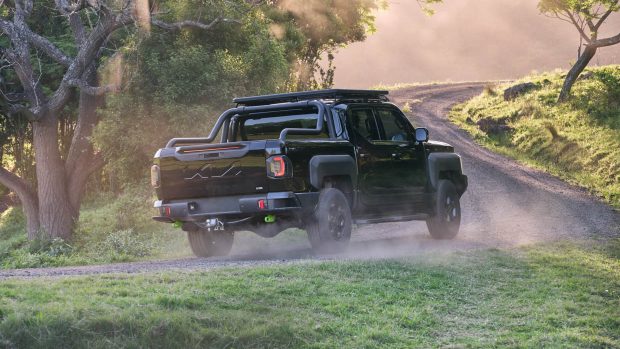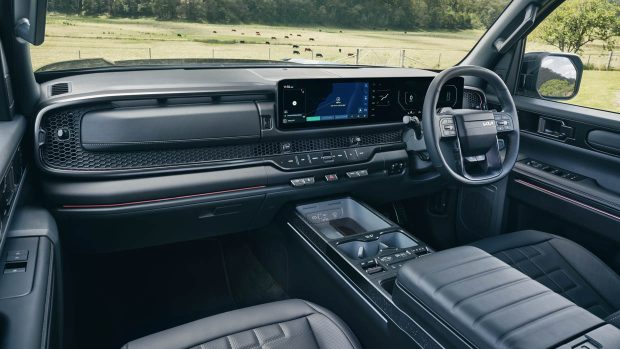-
Car Reviews
- Car News
-
Car Comparisons
Latest comparisons
- Chasing Deals
A deep dive rundown of the three-variant, all diesel-powered ute lineup from its global unveiling
The Kia Tasman has been revealed officially at last, with a bold design and various class-leading claims heralding the South Korean car maker’s first-ever challenger to the likes of the Ford Ranger and Toyota Hilux.
Kia’s debut pickup is due on sale in mid-2025 and enters Australia’s hugely popular ute segment as one of the biggest, with a 5.41-metre length that extends it beyond key rivals. It’s also wider and taller than most competitors.
Three body styles comprise dual-cab, single-cab and cab-chassis, and a trio of trim grades comprise Baseline entry-level model, mid-range X-Line, and the range-topping X-Pro.
Australian Tasmans will be offered with just a single drivetrain – a four-cylinder turbo-diesel, eight-speed auto, and either two-wheel drive (base model) or part-time all-wheel drive.
Here’s Chasing Cars’ guide to all the first key official details about the Kia Tasman.
Click on the links below to jump straight to all the important areas
The Tasman’s styling is one of the key talking points as Kia can’t be accused of being a shrinking violet with its interpretation of a dual-cab ute.
Or in the company’s own words: “The Kia design team deliberately shunned the familiar form language that has dominated the pick-up genre for decades.
This fresh approach to aesthetics strips away the unnecessary to begin with a basic, honest form that highlights the vehicle’s sense of solid power through simple yet functional elements, without relying on the oversized styling that has come to dominate the pickup segment.”
The headlights and LED signature lighting incorporated into the front fender and wheelarch is especially innovative. The dark plastic wheelarch ‘eyebrows’ are likely to be the most polarising aspect of the Tasman’s design.
C-shaped LED tail-lights are housed in a plastic section that links visually to the wheelarch covers.
The tail-lights are kept to the side to accommodate the tailgate that’s stamped proudly with ‘KIA TASMAN’.
Nine exterior colour choices include two palette newbies for Kia: Tan Beige and Denim Blue.
The Tasman is 5410mm long to stretch beyond a Ranger by 40mm and just short of an Ineos Grenadier Quartermaster by 30mm. Width is 1930mm (not including mirrors), height varies from 1870mm (Baseline) to 1920mm (X-Pro, including roof rack).
Coincidentally, the Tasman’s 3270mm wheelbase is identical to that of the Ranger’s.
The Tasman features a segment-traditional body-on-frame platform, with a double-wishbone suspension up front and classic leaf-sprung and solid-axle set-up at the rear.
Variable-frequency dampers and hydraulic rebound control are designed to improve the ute’s body control, comfort, and refinement on different surfaces.
Kia is claiming class-leading on-road refinement for the Tasman. The company says the Tasman incorporates extensive sound-deadening materials, extra wind-sealing strips, and noise-extractor technology.
All Aussie Tasmans will be powered by a 2.2-litre turbo-diesel four-cylinder, mated to an eight-speed auto – with no manual set to be offered at this stage.
The engine is a development of the familiar ‘R-series’ 2.2L found in the likes of the Kia Carnival.
A power output of 154kW matches the Ranger’s twin-turbo diesel 2.0-litre and is slightly above the 150kW offered by the Hilux and Mitsubishi Triton diesel fours.
Maximum torque is rated at 441Nm, which is higher than the 400Nm delivered by a KGM SsangYong Musso but otherwise falls short of the 500Nm Ranger and Hilux, as well as the Triton’s 470Nm.
Kia quotes 10.4 seconds for the Tasman’s 0-100km/h sprint, with a top speed of 185km/h.
There are three drive modes for 4WD models – Eco, Smart and Sport – and additional off-road modes (see Off-Roading section).
The entry Baseline is rear-wheel drive; the 4WD Baseline, X-Line and X-Pro models feature switchable four-wheel drive via a centre console switch.
Australia is skipping a 207kW/421Nm 2.5-litre petrol engine available in other markets, which is paired to either the same eight-speed auto or a six-speed manual and has a quoted 0-100km/h of 8.5 seconds.
A 3500kg braked towing capacity matches the best available in the class.
Kia Australia has previously told Chasing Cars that additional drivetrain options could be added in the future, owing to the extensive model lives of light-commercial vehicles.
Ground clearance is most generous for the most off-road-focused variant, the X-Pro that has a ride height of 252mm. The 2WD Baseline is next best with 231mm, while other models are 224mm.
Kia has yet to provide approach, rampover or departure angles for the Tasman.
Four-wheel-drive Tasmans allow switching between two-wheel-drive High, four-wheel-drive auto, four-wheel-drive High, and four-wheel-drive Low.
They also include Terrain modes comprising Snow/Mud/Sand(Desert)/Rock.
The flagship X-Pro adds a rear electronic locking diff and wears 17-inch all-terrain tyres as standard. Baseline comes with either 17- or 18-inch regular tyres; the X-Line is available with 18-inch alloy wheels wrapped in either standard or all-terrain rubber.
X-Pro has a low-speed cruise control system dubbed X-Trek as another range exclusive.
All models have downhill braking assist and an 800mm wading depth (at 7km/h), matching Ford’s Ranger, for example.
A Ground View Monitor uses the Tasman’s forward-facing camera to relay terrain information to the driver via the central touchscreen. Kia doesn’t specify if the feature is standard or optional, but expect it to most likely feature as standard on the top-grade X-Pro.
The Tasman’s load bed measures 1512mm long, 540mm deep, and 1572mm wide – with 1186mm between the wheelhouses. Kia claims the tray provides a segment-benchmark 1173 litres (VDA).
Ahead of the global reveal presentation, Chasing Cars understands the Tasman’s tray can fit an Aussie pallet (1165 x 1165mm) but is awaiting confirmation whether the specification can accommodate a Euro-size pallet (1200 x 800mm) like the Ranger, Amarok and Triton.
Payload is rated as high as 1195kg for the 2WD Tasman, though is still above the magic tonne mark for 4WD versions (1017kg).
Corner steps provide convenient access to the tub, with other practicality options including 240V power outlet, bed dividers, a sliding cargo floor, and even a mini table for placing coffee cups or portable Bluetooth speakers.
The global Kia Tasman press release referred to four tray configurations, though it’s not clear at this stage what will be available in Australia. What we do know is that Kia Australia is developing a local accessories range for the ute.
The Tasman’s interior follows the trend for modern utes, mixing some of the rugged aesthetics of a workhorse with contemporary, car-style cabin tech.
A relatively low dash – which bodes well for forward vision – is dominated by a trio of digital screens incorporated into a panoramic arrangement, a set-up borrowed from other Kias such as the EV9 large electric SUV.
These comprise a 12.3-inch driver display, a 5.0-inch heating/ventilation display, and a 12.3-inch infotainment touchscreen.
Kia Australia has yet to confirm whether this digital set-up is standard across the range or limited to higher-spec models such as the X-Line and X-Pro. An eight-speaker Harman Kardon audio is offered as an option.
Physical buttons exist on the dash for infotainment menu shortcuts and cabin temperature control, while volume/off-on is among a few switches in the cabin to get the thumb-scroller treatment. The scrollers and cabin-temp buttons feature knurled plastic.
The wide centre console is a work of practicality art, with its headline feature a console bin lid that folds towards the dash to create a working table for laptops.
Open sections include large, dual cupholders and charging trays for two smartphones.
Kia claims the Tasman brings best-in-class headroom, shoulder room, and rear legroom. The rear bench aids comfort with seatback recline (22-30 degrees), while the seat base lifts to reveal a 33-litre storage space.
Buyers can choose from five interior colours, with X-Line and X-Pro models additionally offering two-tone options.
A global launch is too early for local pricing. Expect Kia Australia to announce this crucial information closer to the Tasman’s launch in 2025.
Latest news
About Chasing cars
Chasing Cars reviews are 100% independent.
Because we are powered by Budget Direct Insurance, we don’t receive advertising or sales revenue from car manufacturers.
We’re truly independent – giving you Australia’s best car reviews.











